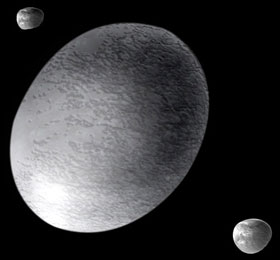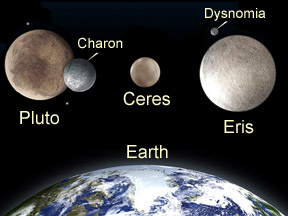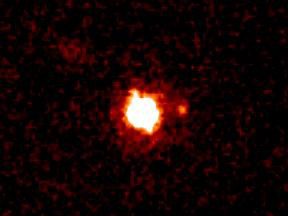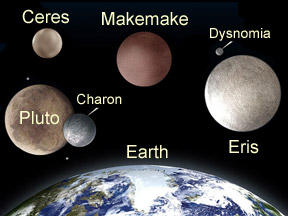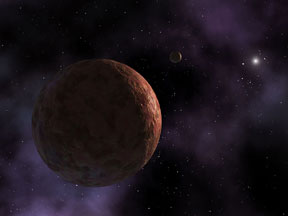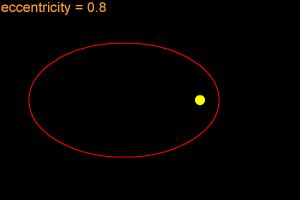Click on image for full size
Images courtesy of NASA, ESA, and A. Feild (STScI).
Haumea (dwarf planet)
Haumea is a dwarf planet in our Solar System. Haumea is the fifth object officially classified as a dwarf planet; the previous four are Pluto, Eris, Ceres, and Makemake. The International Astronomical Union announced Haumea's official status as a dwarf planet in September 2008.
Haumea is a large Kuiper Belt Object (KBO) that orbits far from the Sun on the frozen fringes of our Solar System. Because it is so far away, Haumea takes 285 years to orbit the Sun once! On average, Haumea is about 10% further from the Sun than Pluto, though both of these dwarf planets move closer to and further from the Sun as they go around.
Haumea is smaller than both Pluto and Eris. Haumea is not spherical. Haumea rotates so rapidly that it has been stretched into the shape of an ellipsoid (3D ellipse). This strange body measures 1,960 km (1,218 miles) along its longest axis, but only about half that - 996 km (619 miles) - along its shortest.
The "days" are really short on Haumea. This odd object spins around in less than four hours! That is the shortest rotation period of any known Solar System object larger than 100 km. Haumea is also relatively dense, tipping the scales at 2.6 to 3.3 g/cm3. That probably means it is made mostly of rock, which is somewhat odd since most KBOs have quite a bit of ice (which is less dense) in them. Haumea has known moons, both discovered in 2005. They are named Hi'iaka and Namaka.
Astronomers have a theory that links Haumea's rapid rotation, odd shape, and strange composition. They believe Haumea collided with another large object sometime in the distant past. The collision set Haumea spinning, giving it its odd shape. Outer layers of lightweight ice would have been more easily knocked loose by the collision, leaving behind denser rocks. Haumea's moons may also be leftover debris from the collision.
In Hawaiian mythology, Haumea is the goddess of fertility and childbirth. Her children include Hi'iaka and Namaka, as well as the Hawaiian volcano and fire goddess Pele.
There is some controversy concerning who should be credited with the discovery of Haumea. A group led by Mike Brown of the California Institute of Technology noticed Haumea in December 2004 on images taken in May 2004. Another group, led by José Luis Ortiz Moreno at the Sierra Nevada Observatory in Spain, filed a notification of the discovery of Haumea in July 2005. They had spotted the dwarf planet on images taken in March 2003. It isn't yet clear which group will eventually be given official recognition for the discovery.
Haumea was called 2003 EL61 before it received its official, permanent name. It was formerly nicknamed "Santa" by Brown's group due to its discovery near Christmas in 2004.


